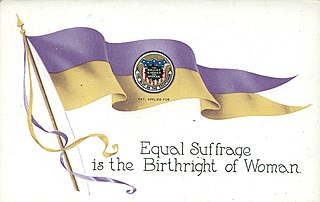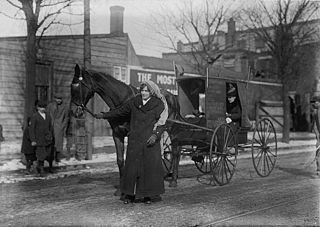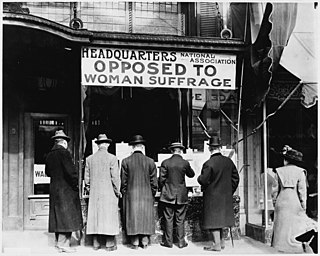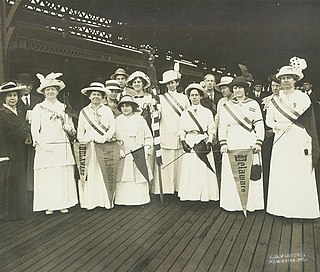
The Nineteenth Amendment to the United States Constitution prohibits the United States and its states from denying the right to vote to citizens of the United States on the basis of sex, in effect recognizing the right of women to vote. The amendment was the culmination of a decades-long movement for women's suffrage in the United States, at both the state and national levels, and was part of the worldwide movement towards women's suffrage and part of the wider women's rights movement. The first women's suffrage amendment was introduced in Congress in 1878. However, a suffrage amendment did not pass the House of Representatives until May 21, 1919, which was quickly followed by the Senate, on June 4, 1919. It was then submitted to the states for ratification, achieving the requisite 36 ratifications to secure adoption, and thereby go into effect, on August 18, 1920. The Nineteenth Amendment's adoption was certified on August 26, 1920.

Mary Ann Camberton Shadd Cary was an American-Canadian anti-slavery activist, journalist, publisher, teacher, and lawyer. She was the first black woman publisher in North America and the first woman publisher in Canada. She was also the second black woman to attend law school in the United States. Mary Shadd established the newspaper Provincial Freeman in 1853, which was published weekly in southern Ontario. it advocated equality, integration, and self-education for black people in Canada and the United States.

The National American Woman Suffrage Association (NAWSA) was an organization formed on February 18, 1890, to advocate in favor of women's suffrage in the United States. It was created by the merger of two existing organizations, the National Woman Suffrage Association (NWSA) and the American Woman Suffrage Association (AWSA). Its membership, which was about seven thousand at the time it was formed, eventually increased to two million, making it the largest voluntary organization in the nation. It played a pivotal role in the passing of the Nineteenth Amendment to the United States Constitution, which in 1920 guaranteed women's right to vote.

Carrie Chapman Catt was an American women's suffrage leader who campaigned for the Nineteenth Amendment to the United States Constitution, which gave U.S. women the right to vote in 1920. Catt served as president of the National American Woman Suffrage Association from 1900 to 1904 and 1915 to 1920. She founded the League of Women Voters in 1920 and the International Woman Suffrage Alliance in 1904, which was later named International Alliance of Women. She "led an army of voteless women in 1919 to pressure Congress to pass the constitutional amendment giving them the right to vote and convinced state legislatures to ratify it in 1920". She "was one of the best-known women in the United States in the first half of the twentieth century and was on all lists of famous American women."

Josephine St. Pierre Ruffin was a publisher, journalist, civil rights leader, suffragist, abolitionist, and editor of the Woman's Era, the first national newspaper published by and for African American women.

Women's suffrage was an important political issue in the late-nineteenth-century New Zealand. In early colonial New Zealand, as in European societies, women were excluded from any involvement in politics. Public opinion began to change in the latter half of the nineteenth century and after years of effort by women's suffrage campaigners, led by Kate Sheppard, New Zealand became the first nation in the world in which all women had the right to vote in parliamentary elections.

The Suffrage Hikes of 1912 to 1914 brought attention to the issue of women's suffrage. Florence Gertrude de Fonblanque organised the first from Edinburgh to London. Within months Rosalie Gardiner Jones had organized the first American one which left from The Bronx to Albany, New York. The second hike was from New York City to Washington, D.C., and covered 230 miles in 17 days.

Alva Erskine Belmont, known as Alva Vanderbilt from 1875 to 1896, was an American multi-millionaire socialite and women's suffrage activist. She was noted for her energy, intelligence, strong opinions, and willingness to challenge convention.

Women's suffrage in Australia was one of the early achievements of Australian democracy. Following the progressive establishment of male suffrage in the Australian colonies from the 1840s to the 1890s, an organised push for women's enfranchisement gathered momentum from the 1880s, and began to be legislated from the 1890s, decades in advance of Europe and North America. South Australian women achieved the right to vote in 1894, and to stand for office in 1895 following the world first Constitutional Amendment Act 1894. This preceded even male suffrage in Tasmania. Western Australia granted women the right to vote from 1899, although with some racial restrictions. In 1902, the newly established Australian Parliament passed the Commonwealth Franchise Act 1902, which set a uniform law enabling women to vote at federal elections and to stand for the federal parliament. By 1908, the remaining Australian states had legislated for women's suffrage for state elections. Grace Benny was elected as the first councillor in 1919, Edith Cowan the first state Parliamentarian in 1921, Dorothy Tangney the first Senator and Enid Lyons the first Member of the House of Representatives in 1943.
The Hall of Fame of Delaware Women was established in 1981 by the Delaware Commission for Women, a division of the Secretary of State of Delaware. The hall of fame recognizes the achievements and contributions of Delaware women in a variety of fields and includes activists, artists, athletes, military personnel and scientists.

Women's suffrage was established in the United States on a full or partial basis by various towns, counties, states and territories during the latter decades of the 19th century and early part of the 20th century. As women received the right to vote in some places, they began running for public office and gaining positions as school board members, county clerks, state legislators, judges, and, in the case of Jeannette Rankin, as a member of Congress.
The Georgia Woman Suffrage Association was the first women's suffrage organization in the U.S. state of Georgia. It was founded in 1890 by Helen Augusta Howard (1865-1934). It was affiliated with the National American Woman Suffrage Association (NAWSA).

The National Association Opposed to Women Suffrage (NAOWS) was founded in the United States by women opposed to the suffrage movement in 1911. It was the most popular anti-suffrage organization in northeastern cities. NAOWS had influential local chapters in many states, including Texas and Virginia.

Women's suffrage in Delaware began in the late 1860s, with efforts from suffragist, Mary Ann Sorden Stuart, and an 1869 women's rights convention held in Wilmington, Delaware. Stuart, along with prominent national suffragists lobbied the Delaware General Assembly to amend the state constitution in favor of women's suffrage. Several suffrage groups were formed early on, but the Delaware Equal Suffrage Association (DESA) formed in 1896, would become one of the major state suffrage clubs. Suffragists held conventions, continued to lobby the government and grow their movement. In 1913, a chapter of the Congressional Union (CU), which would later be known at the National Women's Party (NWP), was set up by Mabel Vernon in Delaware. NWP advocated more militant tactics to agitate for women's suffrage. These included picketing and setting watchfires. The Silent Sentinels protested in Washington, D.C., and were arrested for "blocking traffic." Sixteen women from Delaware, including Annie Arniel and Florence Bayard Hilles, were among those who were arrested. During World War I, both African-American and white suffragists in Delaware aided the war effort. During the ratification process for the Nineteenth Amendment, Delaware was in the position to become the final state needed to complete ratification. A huge effort went into persuading the General Assembly to support the amendment. Suffragists and anti-suffragists alike campaigned in Dover, Delaware for their cause. However, Delaware did not ratify the Nineteenth Amendment until March 6, 1923, well after it was already part of the United States Constitution.

This is a timeline of women's suffrage in Delaware. Suffragists in Delaware began to fight for women's suffrage in the late 1860s. Mary Ann Sorden Stuart and national suffragists lobbied the Delaware General Assembly for women's suffrage. In 1896, the Delaware Equal Suffrage Association (DESA) was formed. Annual state suffrage conventions were held. There were also numerous attempts to pass an equal suffrage amendment to the Delaware State Constitution, but none were successful. In 1913, a state chapter of the Congressional Union (CU) was opened by Mabel Vernon. Delaware suffragists are involved in more militant tactics, including taking part of the Silent Sentinels. On March 22, 1920, Delaware had a special session of the General Assembly to consider ratification of the Nineteenth Amendment. It was not ratified by Delaware until 1923.

Women's suffrage in Florida had two distinct phases. The first women's suffrage effort in Florida was led by Ella C. Chamberlain in the early 1890s. Chamberlain began writing a women's suffrage news column, started a mixed-gender women's suffrage group and organized conventions in Florida. After Chamberlain left Florida in 1897, most women's suffrage activities ceased until around 1912. That year, the Equal Franchise League of Florida was organized in Jacksonville, Florida. Other groups soon followed, forming around the state. Whenever the Florida Legislature was in session, suffragists advocated for equal franchise amendments to the Florida Constitution. In October 1913, property-owning women in Orlando, Florida attempted unsuccessfully to vote. However, their actions raised awareness about women's suffrage in the state. In 1915, the city of Fellsmere allowed municipal women's suffrage and Zena Dreier became the first legal women voter in the South on June 19. By 1919, several cities in Florida allowed women to vote in municipal elections. Florida did not take action on the Nineteenth Amendment, and only ratified it years later on May 13, 1969.
The Wilmington Equal Suffrage Study Club (WESSC) was the name of an African American women's suffrage organization, founded in Wilmington, Delaware, in March 1914.

Mary Clare Laurence Brassington was an American suffragist, president of the Delaware Equal Suffrage Association (DESA) from 1915 to 1917.














